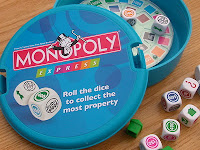I was recently asked about games for very young kids. I haven't looked at games in this age range in a while (since our youngest is eleven), so it was interesting to revisit the gamescape for the booster-seat set.
We still have two in our house that our kids enjoyed back before kindergarten:
Husker Du is essentially Concentration in a kid-friendly format. The board consists of a number of small round "windows" through which symbols on a single rotating disc are visible. Game set-up consists of covering the windows with checkers, then rotating the disc so that new symbols are lined up in the windows under the checkers. Players remove checkers two at a time looking for matching symbols. If they match, they keep the checkers; if not, the checkers cover the symbols again. An old standard memory game, always a good parent-child past-time.
Launch Across is a cross between table-top basketball and Connect Four. Each player has a launcher that propels colored balls against a backboard and down into one of several stacking columns. The first to get four in a straight line row (horizontal, diagonal, or vertical) wins. I'm not usually a fan of dexterity games, but this one is entertaining.
A search of the boardgamegeek.com database turned up a number of good options that are still available on the market:
- "Animal Upon Animal is a simple stacking game, listed for ages 4-99, with 29 cute wooden animals."
- Kids of Carcassone is a tile-laying game patterned after the phenomenally popular Carcassonne with simpler dynamics but, according to some parent reviews, engaging gameplay.
- "Viva Topo! is a [roll-and-move] family game that has players balancing risk and rewards as they attempt to outrun the cat and score for cheese. Players attempt to advance their mice to various goals. The further the goal, the more cheese it is worth. Pursuing the mice is the cat that removes the mice from the game should it catch the mice. Movement is regulated by a die that also moves the cat. Initial cat moves are only 1 space, but become 2 spaces after once around the track, so when the cat speeds up, it's almost all over!"
- Boo Who? (originally Geistertreppe, now available as Spooky Stairs) has a clever feature in which players' pieces are magnetic and become hidden by "ghost" pieces over the course of the game. Players try to remember where their pieces are and get them to the top of the castle stairs to win.
- "Being afraid of monsters is a normal part of growing up. Go Away Monster! encourages kids to conquer that fear by acting it out and taking control. It also lets them experience some of the apprehension and excitement in deciding what is real and what is imaginary. Reach in the bag to find the puzzle pieces that fit your bedroom game board. Try to distinguish between the different puzzle pieces and decide which one feels like the size and shape of a piece you need. If you pull out a monster, don't be scared... You take charge, and the monsters will take off!"
/pic1170672.jpg)
/pic403502.jpg)










